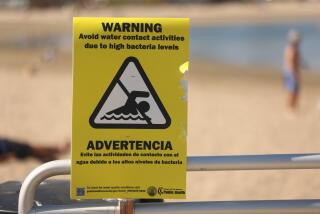Health Warnings Are Back on Beach
- Share via
Despite intensive efforts to keep bacteria-laden runoff from hitting the ocean, Orange County health officials posted new contaminated-water warnings along nearly two miles of Huntington Beach on Wednesday.
The warning came after tests Tuesday found excessive levels of the bacterium enterococcus, usually an indicator of problems with urban runoff, beginning 500 feet south of Magnolia Avenue to 500 feet north of Huntington Street.
After a disastrous summer of beach closures last year, with runoff considered a likely cause, city and county officials are spending nearly $1 million to divert 2.5 million gallons of runoff a day away from the coastline to a sewage treatment plant.
“This is exactly what we were hoping this diversion would take care of, at least for the summer,” said Mary Anne Skorpanich, special projects manager for the Orange County Public Resources and Facilities Department. “There still appears to be something [else] that’s contributing. We’re trying to figure out what it means.”
The health postings, which warn that it is dangerous to swim in the water, were a frustrating turn of events for environmental activists too.
“Oh my gosh. Deja vu,” said Mark Gold, executive director of Heal the Bay. “All I can say is that it’s not for lack of effort. You really have to hand it to all the folks in Orange County for doing what they can on source identification and source abatement. Obviously, they have a more complex problem. Simple diversions aren’t adequate to protecting public health.”
Last summer, about four miles of the beach was fouled for more than two months, putting a severe financial crimp on businesses that rely on beach tourism. Huntington State Beach alone saw a drop of at least $250,000 in revenue, state officials said.
Jack Clapp, owner of Dwight’s beach concession stand a block south of the pier, said last year’s beach contamination “killed business about 90%.”
“I’m worried about it, depending on which way the pollution goes and if it comes up the beach,” said Clapp, who sells fast food and rents in-line skates and body boards. “It could be very dramatic. But again, we’ve had this sort of thing close up a thousand feet of beach or a hundred and the next day it’s back open. I really want to know more.”
Signs were posted on a smaller section of the beach because of a spike in mid-June. If the contamination spreads north, he said, it could cause problems with a two-week surfing competition to begin on the city beach Tuesday.
“Our business is a seasonal business,” Clapp said. “We can’t recapture business. People don’t come down tomorrow and buy two hamburgers instead of one.”
He fears for Huntington Beach’s reputation.
“People have lots of alternatives up and down the coast,” he said. “They can go someplace else.”
Rich Barnard, spokesman for the city, said officials are concerned about the contamination but cautioned against blowing it out of proportion.
“Any time you get any kind of increase in the levels, we get concerned,” he said. “It’s important to recognize that it’s not unique to Huntington Beach. . . . The key is they’re going to take a test tomorrow and it could very well be that it will be fine. We just don’t know.”
Last year, the Orange County Sanitation District, city and county officials spent months and nearly $5 million trying to discover causes of contamination, looking at everything from ground water disruptions tied to the construction of a Huntington Beach Hilton hotel, to a subterranean sewage leak to runoff from Talbert Marsh.
While the source has still not been clearly identified, results from ongoing studies are now due in mid-August, officials said.
More to Read
Sign up for Essential California
The most important California stories and recommendations in your inbox every morning.
You may occasionally receive promotional content from the Los Angeles Times.












